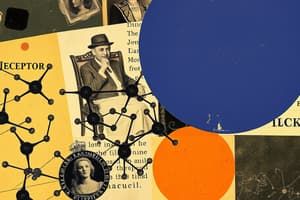Podcast
Questions and Answers
What is the threshold for initiating neuronal action potentials?
What is the threshold for initiating neuronal action potentials?
- -55 mV (correct)
- -70 mV
- -60 mV
- -50 mV
When does the inactivation gate of Na+ voltage-gated channels (VGC) close?
When does the inactivation gate of Na+ voltage-gated channels (VGC) close?
- It remains open throughout
- At the same time as activation gate opens
- Before activation gate opens
- After activation gate opens (correct)
What happens to potassium VGC when the cell repolarizes?
What happens to potassium VGC when the cell repolarizes?
- They open
- They partially open
- They close (correct)
- They remain closed
During the absolute refractory period, what prevents another action potential?
During the absolute refractory period, what prevents another action potential?
How is information coded in action potentials?
How is information coded in action potentials?
What type of axons conduct action potentials faster?
What type of axons conduct action potentials faster?
Which type of fibers are myelinated and conduct impulses at 12-130 m/s?
Which type of fibers are myelinated and conduct impulses at 12-130 m/s?
What type of conduction do myelinated axons use?
What type of conduction do myelinated axons use?
What is the speed of impulse conduction in A fibers?
What is the speed of impulse conduction in A fibers?
What gates do sodium voltage-gated channels (VGC) have?
What gates do sodium voltage-gated channels (VGC) have?
What type of period requires a larger stimulus to reach threshold?
What type of period requires a larger stimulus to reach threshold?
What type of channels open when the cell depolarizes?
What type of channels open when the cell depolarizes?
What predicts membrane potential when the membrane is permeable to multiple ions?
What predicts membrane potential when the membrane is permeable to multiple ions?
What is the resting membrane potential of a neuron?
What is the resting membrane potential of a neuron?
What occurs when the axonal membrane becomes more positive and Na+ voltage-gated channels open?
What occurs when the axonal membrane becomes more positive and Na+ voltage-gated channels open?
What is involved in repolarization of the axonal membrane?
What is involved in repolarization of the axonal membrane?
What is the approximate membrane potential during resting state?
What is the approximate membrane potential during resting state?
What is the primary requirement for action potential generation?
What is the primary requirement for action potential generation?
What are the two gates of the sodium voltage-gated channel?
What are the two gates of the sodium voltage-gated channel?
Where do action potentials occur in a neuron?
Where do action potentials occur in a neuron?
What is the main factor determining ion movement across neuronal membranes?
What is the main factor determining ion movement across neuronal membranes?
What is the primary requirement for depolarization of the axonal membrane?
What is the primary requirement for depolarization of the axonal membrane?
What predicts the equilibrium potential for a specific ion across a membrane?
What predicts the equilibrium potential for a specific ion across a membrane?
What population of channels is unique to the axon, axon hillock, and synaptic terminal for action potential production?
What population of channels is unique to the axon, axon hillock, and synaptic terminal for action potential production?
What is the membrane potential typically close to at rest in neurons?
What is the membrane potential typically close to at rest in neurons?
What is the Nernst potential for K+ given the intracellular and extracellular concentrations of K+ (120 mM and 4 mM, respectively)?
What is the Nernst potential for K+ given the intracellular and extracellular concentrations of K+ (120 mM and 4 mM, respectively)?
What does the Nernst potential describe?
What does the Nernst potential describe?
What does Ohm's law describe in the context of biology?
What does Ohm's law describe in the context of biology?
What is the membrane potential at which the inward and outward movement of an ion through a channel is balanced and equal?
What is the membrane potential at which the inward and outward movement of an ion through a channel is balanced and equal?
What does the Nernst potential not include?
What does the Nernst potential not include?
What is the formula for Ohm's law in the context of biological membranes?
What is the formula for Ohm's law in the context of biological membranes?
Which type of receptors are linked to G-protein signaling and have long-lasting effects, including protein synthesis and intracellular signals?
Which type of receptors are linked to G-protein signaling and have long-lasting effects, including protein synthesis and intracellular signals?
What are essential inhibitory neurotransmitters in the CNS, regulating membrane potential through ionotropic and metabotropic receptors?
What are essential inhibitory neurotransmitters in the CNS, regulating membrane potential through ionotropic and metabotropic receptors?
Which neurotransmitter is the most common excitatory neurotransmitter in the CNS, with NMDA receptors being vital for learning and memory?
Which neurotransmitter is the most common excitatory neurotransmitter in the CNS, with NMDA receptors being vital for learning and memory?
What are the distinct functions of norepinephrine and dopamine in the nervous system?
What are the distinct functions of norepinephrine and dopamine in the nervous system?
What do graded potentials influenced by neurotransmitter action summate to influence?
What do graded potentials influenced by neurotransmitter action summate to influence?
Where do action potentials mainly originate?
Where do action potentials mainly originate?
What do graded potentials permit communication over?
What do graded potentials permit communication over?
What are chemical synapses and graded potentials essential for?
What are chemical synapses and graded potentials essential for?
Where do graded potentials degrade over long distances?
Where do graded potentials degrade over long distances?
Which type of receptors are essential for regulating membrane potential through ionotropic and metabotropic actions?
Which type of receptors are essential for regulating membrane potential through ionotropic and metabotropic actions?
What are the roles of neurotransmitters and their receptors in the nervous system?
What are the roles of neurotransmitters and their receptors in the nervous system?
Which type of receptors have long-lasting effects, including protein synthesis and intracellular signals?
Which type of receptors have long-lasting effects, including protein synthesis and intracellular signals?
Flashcards are hidden until you start studying
Study Notes
Neurotransmitter Receptors and Graded Potentials Overview
- Metabotropic receptors are linked to G-protein signaling and have long-lasting effects, including protein synthesis and intracellular signals.
- Neurotransmitters and their receptors play crucial roles in excitatory and inhibitory behaviors in the nervous system.
- Acetylcholine acts on both excitatory and inhibitory muscarinic receptors, influencing cognitive function and autonomic nervous system activity.
- GABA and glycine are essential inhibitory neurotransmitters in the CNS, regulating membrane potential through ionotropic and metabotropic receptors.
- Glutamate is the most common excitatory neurotransmitter in the CNS, with NMDA receptors being vital for learning and memory.
- Norepinephrine and dopamine have distinct excitatory and inhibitory functions in the nervous system.
- Neurotransmitter binding to ionotropic receptors results in dendrite depolarization or hyperpolarization, affecting membrane potential.
- Graded potentials, influenced by neurotransmitter action, can be excitatory (EPSP) or inhibitory (IPSP) and can summate to influence membrane potential.
- Graded potentials are essential for integrating inputs from multiple neurons and determining whether the axon hillock reaches the threshold for an action potential.
- Chemical synapses and graded potentials add complexity to neuronal communication, allowing for varied and nuanced signaling.
- Action potentials mainly originate in dendrites and cell bodies, while graded potentials arise at trigger zones and propagate along the axon.
- Graded potentials permit communication over short distances and degrade over long distances, while action potentials propagate over longer distances.
Studying That Suits You
Use AI to generate personalized quizzes and flashcards to suit your learning preferences.





